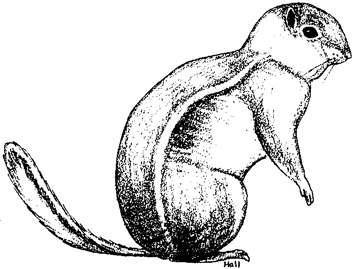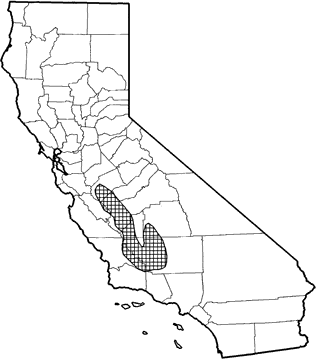
Nelson's Antelope Squirrel
Distribution, Abundance, and Seasonality
Permanent resident of the western San Joaquin Valley from 60-360 m (200-1200 ft) elevation on dry, sparsely vegetated, loam soils. Found from southern Merced Co., south to Kern, Kings, and Tulare cos. Also occurs in portions of eastern San Luis Obispo Co. In 1979, only about 20% of the original range was occupied (California Dept. Fish and Game 1980a). Loss of habitat to cultivation and the effects of rodenticides have contributed to the decline of this species (California Dept. Fish and Game 1980a).

Range Map
Specific Habitat Requirements
Feeding: San Joaquin antelope squirrels feed primarily on insects, green vegetation, seeds, and occasionally on small vertebrates (Hawbecker 1947). Insects were the predominant food items consumed from mid-May to mid-December, and green vegetation (annual grasses and forbs) made up the majority of the diet from mid-December through mid-May. Small vertebrates and seeds of perennial shrubs, annual grasses, and forbs, were eaten throughout the year, accounting for 5-20% of the diet. Seeds may be cached underground (Hawbecker 1947).
Cover: These squirrels dig burrows, or use kangaroo rat burrows. They also use cover provided by rocks and other topographic features (Grinnell and Dixon 1919). Frequent areas with sandy loam soils, widely spaced alkali scrub vegetation, and dry washes.
Reproduction: Nests are constructed in burrows, associated with shrubs such as Atriplex and Ephedra.
Water: Water requirements apparently met largely from diet.
Pattern: Suitable habitat has widely scattered shrubs, annual forbs and grasses, and is distributed over broken terrain with small gullies and washes.
Species Life History
Activity Patterns: Diurnal activity, but avoid hot midday temperatures. Adults may aestivate in summer, but most young squirrels remain active.
Seasonal Movements / Migration: Non-migratory.
Home Range: Hawbecker (1947) found that A. nelsoni foraged over a defined home range. Home ranges varied from 2.6-7.2 ha (6.4-17.8 ac), with a mean of 4.4 ha (19 ac) (Hawbecker 1958). Moderate densities of 3-10 squirrels/ha (1.2-4/ac) were found on about 41,000 ha (101,000 ac) (Williams 1980).
Territory: No data found, but descriptions suggest territoriality (Hawbecker 1947,1951,1953,1958).
Reproduction: Breeding occurs from February into May, with a peak in April. Little other data available. One litter of 10 reported. These squirrels live in family groups. Abundant annual vegetation improves survival of young.
Niche: San Joaquin antelope squirrels may compete for seeds, to a limited extent, with sympatric species of Dipodomys. Conversely, they benefit from using burrows and seed caches of Dipodomys. Domestic sheep and cattle may compete with A. nelsoni for green vegetation (Hawbecker 1947). Badgers, kit foxes, red-tailed hawks, golden eagles, coyotes, and various snakes prey on A. nelsoni.
Sources & References
California Department of Fish and Game, 1999.
California's Wildlife, Sacramento, CA.
Written by: G. Ahlborn, reviewed by: M. White, edited by: M. White
California Department of Fish and Game. 1980a. At the crossroads: a report on the status of California's endangered and rare fish and wildlife. Sacramento. 149pp. Grinnell, J., and J. Dixon. 1919. Natural history of the ground squirrels of California. Calif. State Comm. Horticulture Bull. 7:597-708. Hawbecker, A. C. 1947. Food and moisture requirements of the Nelson antelope ground squirrel. J. Mammal. 28:115-125. Hawbecker, A. C. 1951. Small mammal relationships in an Ephedra community. J. Mammal. 32:50-60. Hawbecker, A. C. 1953. Environment of the Nelson antelope ground squirrel. J. Mammal. 34:324-334. Hawbecker, A. C. 1958. Survival and home range in the Nelson antelope ground squirrel. J. Mammal. 39:207-215. Williams, D. F. 1980. Distribution and population status of the San Joaquin antelope squirrel and giant kangaroo rat. Calif. Dep. Fish and Game, Sacramento. Nongame Wildl. Invest. Final Rep. E-W-4, IV-10.1. 46pp.
California Animal Facts | California's Wildlife